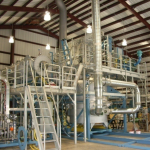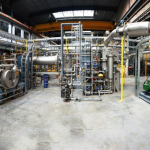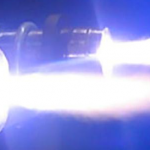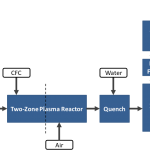Introduction
PyroGenesis is pleased to provide you with this Technical and Commercial Proposal for the supply of a Steam Plasma Arc Refrigerant Cracking System (SPARC-10™) for your operations. In this current section, an introduction to PyroGenesis, along with an outline of our qualifications for this work is provided. In Section 2, our Technical Proposal is presented, which includes a description of the SPARC-10™ Process, a review of how SPARC-10™ will address your technical requirements, specific details of our scope of supply, and an introduction to our PyroClassTM Technical Support. In Section 3, our Financial Proposal is outlined.
PyroGenesis
PyroGenesis Canada Inc. is the world leader in the design, development, manufacture and commercialization of advanced plasma processes and systems. With over 40 employees, PyroGenesis provides cutting-edge contract research, as well as turnkey process equipment packages to the chemical, defense, metallurgical, and environmental industries. With its PyroClassTM team of experienced engineers, scientists and technicians working out of its Montreal office and a 3,500 m2 state-of the art manufacturing facility, PyroGenesis maintains its competitive edge at the forefront of research and development (R&D), technology demonstration, and commercialization. PyroGenesis Canada is a publicly-traded, Canadian company on the TSX Venture Exchange (Ticker Symbol PYR). PyroGenesis’ Montreal operations are ISO 9001:2008 certified, and have been since 1997 (see Appendix A for a copy of the certificate).
PyroGenesis’ core competencies lie in the development of innovative plasma waste processing, waste-to-energy and material transformation systems and technologies. These systems have been proven to be safe, reliable, efficient and easy to operate. In particular, the plasma waste destruction platform which forms the foundation for all of our waste processing technologies (such as those operating for the US Department of Defense) is at the core of the SPARC-10TM process being offered in this proposal.
Moreover, this platform has been used to completely destroy a wide variety of wastes, including municipal, hazardous, industrial and biomedical waste. More specifically, chemical wastes such as sludge oils and refrigerant waste have been processed with destruction efficiencies of more than seven “9s” i.e. > 99.99999%, all the while effectively abating the highly corrosive gases generated, easily complying with the most stringent environmental regulations.
At the core of all of our systems is the work of our dynamic, multi-disciplinary staff of scientists, engineers and technologists, an excellent basis to offer our innovative products and dynamic PyroClassTM Engineering Services to the marketplace. Their experience, hard work, project management capabilities and know-how have led to highly successful commercial deployments, contract research endeavors, along with the supply of comprehensive process engineering packages and techno-economic feasibility studies. Our staff provides the foundation which has established PyroGenesis as THE WORLD LEADER in plasma processing technology, and as the preferred technology development partner for all of industry.
Qualifications
In 2011, two major “game-changing” events took place, which have not only changed the face of the industry, but have placed PyroGenesis as the indisputable leader within it and the “one-to-watch”:
PyroGenesis announced that the US Air Force had formally accepted its 10.5 tonnes per day (TPD) Plasma Resource Recovery System (PRRS), the company’s waste to energy technology, at its Air Force Special Operations Command (AFSOC) base in Hurlburt Field, Florida, USA. This plant was designed to process municipal solid waste, as well as industrial and medical waste, while generating electricity using an internal combustion engine, and producing an inert slag for use in construction materials. The Hurlburt Field facility was a showcase for both the US Air Force and for PyroGenesis in how plasma has become an effective and greener alternative to landfill or incineration. The success of the Hurlburt Field project has also formed the foundation for both the scale-up of the technology (up to 100 TPD per module) and for its launch into other market sectors, for applications in municipalities and in industry.
PyroGenesis announced that the US Navy had accepted PyroGenesis’ 5 TPD Plasma Arc Waste Destruction System (PAWDS) for their new aircraft carrier, the Gerald R. Ford (CVN-78), currently undergoing sea trials at Newport News Shipbuilding (NNS), in Virginia, USA. Developed in collaboration with the US Navy, at 1/5th the size and half the weight of a typical marine incinerator, the patented PAWDS is a novel technology for the highly compact, inherently safe and efficient destruction of shipboard wastes. As such, the system has been specified into all of the forthcoming Ford-class carriers, a fact which was illustrated by NNS’ re-order of a PAWDS for the John F. Kennedy (CVN-79), a system which will be delivered in early 2015.
In 2014, PyroGenesis started up its first Steam Plasma Arc Refrigerant Cracking System (SPARC-50TM – 50 kg/h, R-12 basis). Using the company’s latest innovation, the steam plasma torch, along with its proven plasma technology platform, SPARCTM destroys CFC, HCFC and HFC-based refrigerants collected at Recyclage EcoSolutions, a refrigerator recycling facility in Laval, Quebec, Canada. With the ease of operation features that all PyroGenesis systems possess, the SPARCTM substantially reduces the operating costs associated with third-party disposal of the waste with onsite destruction capabilities. With the successful start-up of SPARCTM, with the world stockpile in ozone-depleting substances and replacement “super greenhouse gas-generating” refrigerants ever increasing, and with the potential use of the technology with other, potentially nasty hazardous chemicals, PyroGenesis is launching two versions of SPARCTM into many markets worldwide starting in 2015, a 10 kg/hr & a 50 kg/hr version (R-12 basis) – SPARC-10™ and SPARC-50™ respectively.
Also in 2014, PyroGenesis was commissioned in 2014 by a military consortium to design, develop and deliver a prototype Tactical Plasma Arc Chemical Warfare Agents Destruction System (Tactical PACWADS) for the destruction of Sarin, Mustard, VX and other liquid chemical warfare agents (CWA) and precursors. Tactical PACWADS is a mobile, small-scale unit designed to be deploy where the CWA are located. This contract is currently underway, with delivery and testing of the prototype scheduled to commence in the second half of 2015. SPARC-10™ borrows from the Tactical PACWADS design to offer a small footprint, lower cost solution to the industry.
This has placed PyroGenesis at the forefront of this industry, and has poised the company for the deployment of plasma-based technologies in other military, commercial and industrial applications. In fact, more recent announcements in the oil & gas field, with chemical warfare agent destruction and in providing 3D printing-grade powder production processes, continue to bolster PyroGenesis’ position as a world leader in plasma processing.
PyroGenesis’s other key business lines: Plasma Torches and PyroClassTM Engineering Services – reinforce the company’s strategic advantage in the marketplace. Our strength in these two “stand-alone” business lines positions PyroGenesis as a first mover in the clean-technology and renewable energy fields.
PyroGenesis’ line of plasma torches offer simple, one-touch operation and provide unparalleled, long-lasting electrode life, critical for both military and commercial use. These devices are at the heart of the company’s line of plasma waste technology platforms. The qualification of PyroGenesis’s torches by the US Department of Defense has ultimately led to the wider acceptance of the company’s plasma torches, as highlighted by the recent sales of multiple torch systems to an overseas metallurgical company for mineral processing, and to an Asian company who look to deploy the torches in a waste-to-energy gasification process.
PyroGenesis’ manufacturing facility is a 3,500 m2 (38,000 ft2) building, located about 5-10 minutes from the company’s head office in Montreal. The facility includes a PRRS pilot plant, a full-scale PAWDS, a metallurgical processing prototype, and a plasma torch testing booth for new developments and long duration trial. The facility is also equipped with a machine shop, a welding station, along with electrical and mechanical assembly capability. With a large power input, the availability of this development facility is a key asset that sets PyroGenesis apart from most other plasma companies.
PyroGenesis’s technologies, products and services provide clear benefits to our customer base. The company’s systems are environmentally sound, inherently safe, scalable and easy to operate.
- Ribbon Cutting Ceremony – Hurlburt Field, Florida
- PRRS – Primary Gasification Furnace and Secondary Gasification Chamber
- PAWDS for CVN-78 Aircraft Carrier during Factory Acceptance Testing
- PyroGenesis’ Air Plasma Torches
Technical Proposal
This proposal outlines how SPARC-10TM will address and surpass all of your technical requirements, and how our PyroClassTM Technical Support can accompany you throughout the service life of the equipment, a projected span of at least 20 years.
SPARC-10TM Benefits
Evolving from PyroGenesis’ plasma technology platforms developed for the US Military, the SPARC-10TM System is a highly effective, patented process (US Patent No. 8,716,546) for the complete destruction of ozone-depleting substances (ODS) and other environmentally noxious refrigerants and chemicals. Developed with the support of the Governments of Canada and Québec , the first SPARCTM system, at a rated capacity of 50 kg/hour (R-12 basis), was deployed in 2014 as a full-scale demonstration unit at Recyclage EcoSolutions (RES), a refrigerator recycling facility in Laval, Québec, Canada. Third-party emissions testing while processing R-11, R-12, R-22 and R-134a refrigerants has shown that SPARCTM easily surpassed all “TEAP Guidelines Technical Performance Qualifications” for destruction removal efficiency and for abatement of dioxins & furans, HCl, HF, CO and particulates:
With these impressive results, SPARC-10TM is ready for deployment at your facility.
Why SPARC-10TM? Here are some of the key benefits and features of the SPARC-10TM System:
- SPARC-10TM far exceeds the UNEP Ozone Secretariat TEAP Requirements for ODS Destruction, facilitating the creation of carbon offset projects in either the compliance (i.e. Cap-and-Trade) or voluntary carbon markets.
- Using inexpensive steam as the plasma-forming gas substantially reduces the operating costs versus other approaches which use expensive gases such as argon.
- SPARC-10TM keeps its carbon footprint to a minimum through the use of electricity only as an energy source, a clean alternative to fossil fuel incineration processes;
- SPARC-10TM uses steam plasma and its electron-rich reactive environment, to create the perfect thermal and chemical conditions for the complete destruction of the refrigerant through the Steam Hydrolysis reaction, as opposed to incineration.
- The Steam Hydrolysis reaction also has the added benefit of 100 times lower flue gas flow rates and reduced pollutant levels versus incineration.
- The acid gases formed from SPARC-10TM are easily removed using a wet scrubber, as opposed to other processes (ex. oxygen plasma-based systems) where chlorine (Cl2) and fluorine (F2) gases are formed.
- The small footprint SPARC-10TM System is safe, simple to operate and easy to maintain, all hallmarks of systems provided by PyroGenesis, a company with more than 20 years of experience in serving demanding industries such as the Defense and Environmental sectors.
SPARC-10TM Process Overview
Here is how SPARC-10TM works: the refrigerant is fed continuously through a specifically-designed feed flange into the Two-Zone Plasma Reactor in front of the steam plasma plume. The design of this flange is paramount to ensuring optimal mixing between the feed refrigerant and the steam plasma, and ultimately to ensuring maximum destruction removal efficiencies.
Under the steam plasma plume, which provides intense heat, and highly reactive species, the stable, long-chain refrigerant chemicals are cracked into smaller compounds such as carbon monoxide (CO), carbon dioxide (CO2), hydrogen fluoride (HF), hydrogen chloride (HCl) and hydrogen (H2). This mixing and cracking occurs in the first equilibrium zone of the reactor where the necessary residence time is maintained at high temperatures (> 1,300oC) to complete the destruction reactions.
Air can be added in the second equilibrium zone of the reactor to complete the combustion of the residual CO and H2 to CO2 and Water (H2O), depending on the refrigerant being processed.
At the discharge of the reactor, the hot gas mixture is rapidly quenched with a spray of fresh water to reduce the temperature of the gases to below 80oC to avoid the formation of dioxins and furans. The quench water is collected in a tank and used as process water to scrub the cold gas.
The cold gases enter a packed column, where the HF and HCl are scrubbed out through a downward flow of neutralized process water. The whole process is maintained under negative pressure by a corrosion-resistant induced draft (ID) fan, which directs the cooled, scrubbed gases (free of refrigerant, acids, dioxins/furans, CO) to the atmosphere.
The process water is neutralized continuously with a 50% caustic soda (NaOH) solution and a pH control loop, producing sodium chloride (NaCl) and sodium fluoride (NaF) salts which then can be treated or discharged as per local wastewater regulations.
- SPARC-10TM Process Block Diagram
- Steam Plasma Torch Installed on Two Zone Plasma Reactor
- SPARC-10TM Process Skid, with Two-Zone Plasma Reactor, Packed Column, Process Water Tank and Accessory Equipment (8’ x 20’ x 12’ high assembly)
Want to know more? Contact us!









